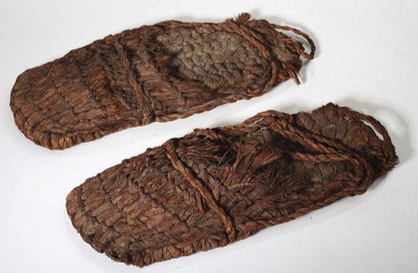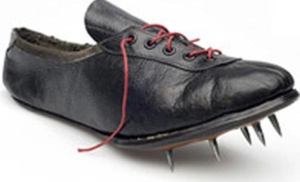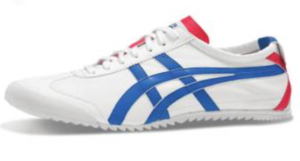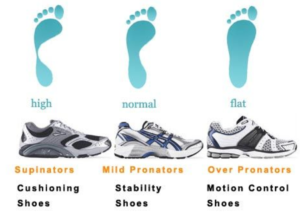What running shoe is “right” for me?
As a Sports Physical Therapist who works with a lot of runners, I am asked this question frequently. These poor, unsuspecting souls typically get a 20-minute diatribe as an answer. Allow me to explain.
History of Running Shoes
Shoes began purely as a method of protecting the soles of our feet from rough terrain. The earliest documented footwear is a pair of sagebrush fashioned sandals found in the Fort Rock caves in Oregon.

These shoes date back 10,000 years!
Fast-forward a few thousand years… In 1868 vulcanized rubber was invented. In 1916, Goodyear Co. took advantage of this to create a flexible sole’. They attached a canvas upper and introduced ‘Keds’. Keds were advertised as ‘sneakers’ because they said: it was so quiet, you could sneak up on someone.
“Running shoes” at the time consisted of spiked leather shoes.

JW Fosters added spikes under the forefoot of athletic shoes and marketed the first “running shoe” in 1985. This eventually gave birth to the company ‘Reebok’
Adolf Dassler offered the first “customized running shoe” in 1926 – the essentially meant that spike were offered in various patterns and lengths depending in whether it was used for distance or sprinting. Dasslers shoes were worn by Jesse Ownes in 1936, and his company eventually became known as Adidas.
In 1964 we see the first pair of cushioned running shoes introduced by Mr. Onitsuke of Jason – the Tiger.

This spurned the creation of Axis and got the attention of a couple of well-known track coaches from Oregon. Phil Knight & his mentor Bill Bowerman eventually decided to tweak this prototype from Onitsuke and developed their own shoe – the Cortez… Their company was later named Nike.
(Image)
Modern Dilemma
The very first reports of injury rates in runners came out in 1970. Published in a then new magazine, ‘Runners World’ – the injury rates hovered ~ 70-80%. That is, 70-80% of all runners will experience an injury in a given year.
Thus began the push to ‘solve’ this problem. Popular assumption at the time (pushed primarily by a collaboration of sports podiatrists hired by Nike) was that if a shoe could cushion the impact of running and/or control “unwanted amounts of pronation” then these injuries could be prevented. This was the cutting edge in biomechanical theory in the 1970’s when shoe technology was in it’s infancy; and it lives on today in spite of absolutely no good research to support the idea that shoes do a good job of either.
Fast-forward 40 years and we have too many companies to keep track of: Brooks, NewBalance, Saucony, and the slew of newcomers… Over this period of time, shoes became gradually more and more engineered. More cushioned. More controlling of motion (at least in theory). We have kinetic wedges and spring coils. We even have a shoe that claims to adjust (or “tune”) variably based on a woman’s menstrual cycle!
A wide swath of well-intentioned technology and full-blown gimmicks fill the shelves of shoe stores.

Modern day running shoes are often classified into 3 main “categories” – ‘Neutral’, ‘Stability’, and ‘Motion Control’ shoes. Most competitive and recreational runners are familiar with the popular “wet foot” test to match their foot-type to the appropriate shoe.
Essentially flat-arched feet are steered towards shoes with more correction (motion control shoes), high-arched feet are encouraged to seek more cushion (neutral shoes), and those towards the middle are encouraged to select a stability shoe.
The problem? Over the past 4-5 decades, in spite of all of this “technology”, and the growth of a billion dollar industry, injury rates remain unchanged. We still see yearly injury rates of about 70-80%.
So What’s the Answer?
Before we attempt to resolve why advancements in running shoes technology has failed to reduce injury rates, we must first challenge a few assumptions.
1) Pronation is bad.
2) The right shoe will can reduce ‘pronation’
3) Impact is bad.
4) The right shoe will help cushion / reduce impact?
Let’s weed through the myth, hype and nonsense…
Here’s what we now know:
-
Pronation is not a 4-letter word.
Professor Nigg from the University of Calgary, one of the world’s foremost experts on biomechanics, published a literature review in the British Journal of Sports Medicine just this past year. He scoured through the past 10 years of research investigating the link between pronation and injuries. His conclusion – this commonly held belief is a myth. Pronation, the majority of the time, is not a dysfunction requiring correction.
It should be pointed out that “severe” pronators, or runners with current injuries that have been linked to “excessive” pronation are perhaps a different story. However, the vast majority of pronating feet do not require any special shoe wear (but they would do well with a good strengthening routine!)
One particularly great study came out in 2014. The authors looked prospectively at almost 1000 beginner runner. These new runners were classified based on “foot type”, but were all given the same (neutral) shoe. The runners were then followed for a year. What they found was that the group of ‘Pronators’ actually had a lower rate of injury, even though the shoes provided had no built in “correction”. 1
Conclusion – “a pronated foot position is, if anything, an advantage with respect to running injuries.”
-
The ability of a shoe to control pronation is equivocal at best.
While there are some studies showing reduced pronation in motion control shoes, there are just as many (or more) challenging this. There are even studies showing reduced pronation when barefoot! (The barefoot vs. shoed running discussion or forefoot vs heel striking discussion is a whole other consideration. Click here for more). 2 3 4
You see, the problem is that shoes with a lot of ‘correction’ or ‘cushion’ in them impair the runners ‘feel’ or proprioception. Often times this may lead to a more relaxed foot on impact, or other gait adaptations that can in fact increase total pronation (or other important factors like ‘pronation velocity’). While running shoes may position the foot in a more “neutral” position while standing, actually running is a completely different animal. Jay Dicharry is a running researcher who demonstrated this well. There study showed that the ability of the shoe to control foot mechanics when running was very limited. 5
His suggestion: “The soft materials in modern running shoes… can impair the foot’s ability to react to the ground. This can mute or alter feedback the body gets while running. These factors allow a runner to adopt a gait that causes… elevated forces observed” in the foot and ankle. (pronation being just one of those forces)
Research has shown that distance running in Motion Control shoes seems to be an independent risk factor for injury – both in terms of frequency of ‘nagging’ injuries and missed running days from significant injury. 6
-
Impact is not necessarily bad.
In fact, many tissues in the body (for example the articular cartilage in your knee) require intermittent loading and unloading to maintain tissue health.
“Repetitive impact loading for cartilage and soft tissue structures falls within the acceptable window for moderate and intensive running and… impact loading for bone may sometimes fall outside the acceptable window for intensive running with inappropriate recovery periods.” 7 – Nigg and Wakeling
In other words, in the absence of a training error, or some gross biomechanical issue, the impact associated with running may not be such a ‘bad’ thing.
-
Cushion shoes do not necessarily reduce impact.
How you run effects impact loads far greater than what shoe you have on.
Example: Despite being in a cushioned / modern running shoe, RFS runners have clocked impact forces (measured in the hip and knee) upto 2-3x the runners bodyweight! 8
Runners with a Forefoot Strike (FFS) pattern, running in minimalist shoes, average impact forces of ~ 50-60% of body weight. 9
Example: Impact forces felt under the kneecap increase dramatically with heel striking (vs forefoot striking), 10 11 when landing with reduced knee flexion, when over striding,12 etc.
Example: Impact loads to the Tibia (shin bone) increase (as does the risk of stress fracture) if a runner is ‘bouncing’ excessively (vertical displacement > 2-3 inches) 13
I could give 20+ examples. How you run effects impact loads. Running shoes, even ‘high cushioning’ running shoes… not so much. 14 15
They “feel” cushy to the foot – Yes. But this does not translate to reduce impact up the biomechanical chain (knee, hip, back)
So, what do you do with this information?
Realize that “matching” foot type to shoes based on arch height does not prevent injury. 16 17 18 Realize that the ‘wet foot test’ commonly employed at running shoe stores is meaningless. Some research has actually shown that this “matching” actually increased the risk of injury when compared to shoes given out totally at random! 19
Chose a shoe based on feel!
It turns out we are really good judges of what is “right” for ourselves. An interesting study in 2001 took military recruits and broke them into 2 groups. One group given shoes at random, and a second group that was provided a wide range of shoes (and inserts) to try on and told to pick whatever felt most comfortable. The second group reported far fewer injuries. 20
- Nielsen, R. O., Buist, I., Parner, E. T., Nohr, E. A., Sørensen, H., Lind, M., & Rasmussen, S. (2013). Foot pronation is not associated with increased injury risk in novice runners wearing a neutral shoe: a 1-year prospective cohort study. Br J Sports Med, bjsports-2013.
- De Wit, B., De Clercq, D., & Aerts, P. (2000). Biomechanical analysis of the stance phase during barefoot and shod running. Journal of biomechanics, 33(3), 269-278.
- Morley, J. B., Decker, L. M., Dierks, T., Blanke, D., French, J. A., & Stergiou, N. (2010). Effects of varying amounts of pronation on the mediolateral ground reaction forces during barefoot versus shod running. Journal of Applied Biomechanics, 26(2), 205-214.
- Stacoff, A., KÄlin, X., & Stüssi, E. D. G. A. R. (1991). The effects of shoes on the torsion and rearfoot motion in running. Medicine and Science in Sports and Exercise, 23(4), 482-490.
- Kerrigan, D. C., Franz, J. R., Keenan, G. S., Dicharry, J., Della Croce, U., & Wilder, R. P. (2009). The effect of running shoes on lower extremity joint torques. Pm&r, 1(12), 1058-1063.
- Ryan, M. B., Valiant, G. A., McDonald, K., & Taunton, J. E. (2011). The effect of three different levels of footwear stability on pain outcomes in women runners: a randomised control trial. British journal of sports medicine, 45(9), 715-721.
- Nigg, B. M., & Wakeling, J. M. (2001). Impact forces and muscle tuning: a new paradigm. Exercise and sport sciences reviews, 29(1), 37-41.
- Altman, A. R., & Davis, I. S. (2012). Barefoot running: biomechanics and implications for running injuries. Current sports medicine reports, 11(5), 244-250.
- Mullen, S., & Toby, E. B. (2013). Adolescent runners: the effect of training shoes on running kinematics. Journal of Pediatric Orthopaedics, 33(4), 453-457.
- Kulmala, J. P., Avela, J. A. N. N. E., Pasanen, K. A. T. I., & Parkkari, J. A. R. I. (2013). Forefoot strikers exhibit lower running-induced knee loading than rearfoot strikers. Medicine & Science in Sports & Exercise, 45(12), 2306-2313.
- Bonacci, J., Saunders, P. U., Hicks, A., Rantalainen, T., Vicenzino, B. G. T., & Spratford, W. (2013). Running in a minimalist and lightweight shoe is not the same as running barefoot: a biomechanical study. Br J Sports Med, 47(6), 387-392.
- Heiderscheit, B. C., Chumanov, E. S., Michalski, M. P., Wille, C. M., & Ryan, M. B. (2011). Effects of step rate manipulation on joint mechanics during running. Medicine and science in sports and exercise, 43(2), 296.
- Zadpoor, A. A., & Nikooyan, A. A. (2011). The relationship between lower-extremity stress fractures and the ground reaction force: a systematic review. Clinical biomechanics, 26(1), 23-28.
- Lieberman, D. E., Venkadesan, M., Werbel, W. A., Daoud, A. I., D’Andrea, S., Davis, I. S., … & Pitsiladis, Y. (2010). Foot strike patterns and collision forces in habitually barefoot versus shod runners. Nature, 463(7280), 531-535.
- Lieberman, D. E. (2012). What we can learn about running from barefoot running: an evolutionary medical perspective. Exercise and sport sciences reviews, 40(2), 63-72.
- Knapik, J. J., Swedler, D. I., Grier, T. L., Hauret, K. G., Bullock, S. H., Williams, K. W., … & Jones, B. H. (2009). Injury reduction effectiveness of selecting running shoes based on plantar shape. The Journal of Strength & Conditioning Research, 23(3), 685-697.
- Knapik, J. J., Brosch, L. C., Venuto, M., Swedler, D. I., Bullock, S. H., Gaines, L. S., … & Jones, B. H. (2010). Effect on injuries of assigning shoes based on foot shape in air force basic training. American journal of preventive medicine, 38(1), S197-S211.
- Knapik, J. J., Trone, D. W., Swedler, D. I., Villasenor, A., Bullock, S. H., Schmied, E., … & Jones, B. H. (2010). Injury reduction effectiveness of assigning running shoes based on plantar shape in Marine Corps basic training. The American journal of sports medicine, 38(9), 1759-1767.
- Knapik, J. J., Trone, D. W., Tchandja, J., & Jones, B. H. (2014). Injury-reduction effectiveness of prescribing running shoes on the basis of foot arch height: summary of military investigations. journal of orthopaedic & sports physical therapy, 44(10), 805-812.
- MÜndermann, A., Stefanyshyn, D. J., & Nigg, B. M. (2001). Relationship between footwear comfort of shoe inserts and anthropometric and sensory factors. Medicine & science in sports & exercise, 33(11), 1939-1945.
- Luo, G., Stergiou, P., Worobets, J., Nigg, B., & Stefanyshyn, D. (2009). Improved footwear comfort reduces oxygen consumption during running. Footwear Science, 1(1), 25-29.



Leave a Reply
Want to join the discussion?Feel free to contribute!